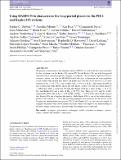Using HARPS-N to characterize the long-period planets in the PH-2 and Kepler-103 systems
Abstract
We present confirmation of the planetary nature of PH-2b, as well as the first mass estimates for the two planets in the Kepler-103 system. PH-2b and Kepler-103c are both long-period and transiting, a sparsely populated category of exoplanets. We use Kepler light-curve data to estimate a radius, and then use HARPS-N radial velocities to determine the semi-amplitude of the stellar reflex motion and, hence, the planet mass. For PH-2b we recover a 3.5σ mass estimate of Mp=109+30−32 M⊕ and a radius of Rp = 9.49 ± 0.16 R⊕. This means that PH-2b has a Saturn-like bulk density and is the only planet of this type with an orbital period P > 200 d that orbits a single star. We find that Kepler-103b has a mass of Mp,b=11.7+4.31−4.72 M⊕ and Kepler-103c has a mass of Mp,c=58.5+11.2−11.4 M⊕. These are 2.5σ and 5σ results, respectively. With radii of Rp,b=3.49+0.06−0.05 R⊕ and Rp,c=5.45+0.18−0.17 R⊕, these results suggest that Kepler-103b has a Neptune-like density, while Kepler-103c is one of the highest density planets with a period P > 100 d. By providing high-precision estimates for the masses of the long-period, intermediate-mass planets PH-2b and Kepler-103c, we increase the sample of long-period planets with known masses and radii, which will improve our understanding of the mass–radius relation across the full range of exoplanet masses and radii.
Citation
Dubber , S C , Mortier , A , Rice , K , Nava , C , Malavolta , L , Giles , H , Coffinet , A , Charbonneau , D , Vanderburg , A , Bonomo , A S , Boschin , W , Buchhave , L A , Cameron , A C , Cosentino , R , Dumusque , X , Ghedina , A , Harutyunyan , A , Haywood , R D , Latham , D , López-Morales , M , Micela , G , Molinari , E , Pepe , F A , Phillips , D , Piotto , G , Poretti , E , Sasselov , D , Sozzetti , A & Udry , S 2019 , ' Using HARPS-N to characterize the long-period planets in the PH-2 and Kepler-103 systems ' , Monthly Notices of the Royal Astronomical Society , vol. 490 , no. 4 , pp. 5103–5121 . https://doi.org/10.1093/mnras/stz2856
Publication
Monthly Notices of the Royal Astronomical Society
Status
Peer reviewed
ISSN
0035-8711Type
Journal article
Description
Funding: Senior Kavli Institute Fellowships at the University of Cambridge (AM); UK Science & Technology Facilities Council (STFC) consolidated grant number ST/R000824/1 (ACC).Collections
Items in the St Andrews Research Repository are protected by copyright, with all rights reserved, unless otherwise indicated.

